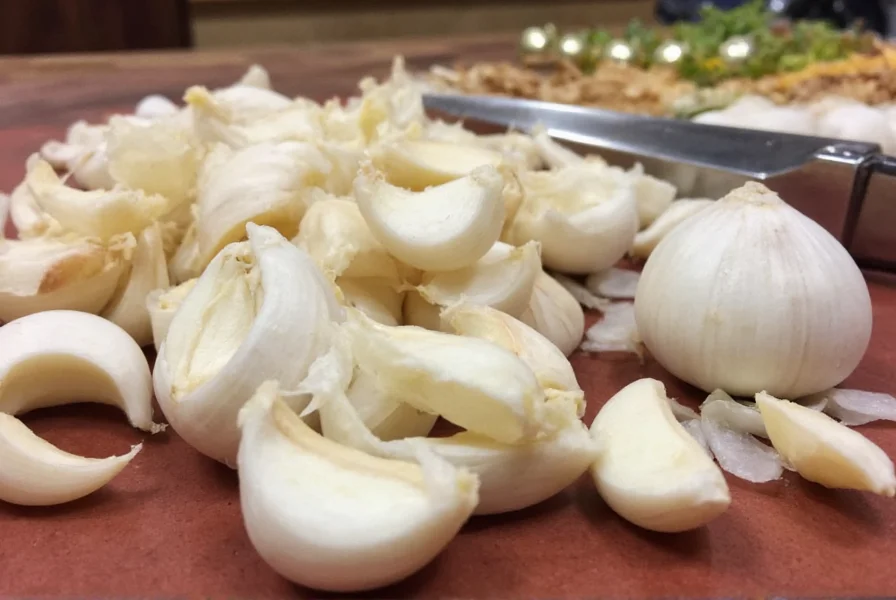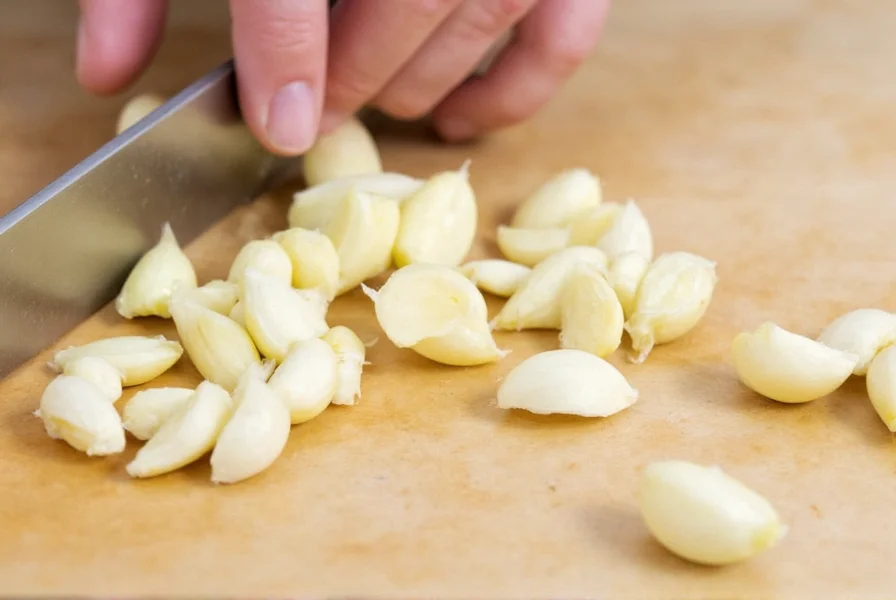Chopping garlic properly transforms both your cooking experience and final dish. Many home cooks struggle with garlic sticking to knives, uneven cuts, or wasting precious cloves. The right technique ensures optimal flavor release while minimizing frustration and maximizing safety in the kitchen.
Why Proper Garlic Chopping Matters
When you chop garlic, you're not just cutting it into smaller pieces—you're triggering chemical reactions that develop its signature flavor. Crushing or chopping breaks garlic cells, allowing enzymes to interact with other compounds and create those delicious aromatic molecules. The finer you chop, the more surface area exposed, and the stronger the flavor becomes. Understanding how to chop garlic cloves properly directly impacts your dish's taste profile.
Essential Tools for Chopping Garlic
You don't need specialized equipment, but the right tools make how to chop garlic cloves much easier:
| Tool | Best For | Alternative |
|---|---|---|
| Chef's knife (8-inch) | Most versatile for chopping, mincing, and smashing | Utility knife (6-inch) |
| Wooden cutting board | Provides stable surface that won't dull knife edge | Plastic board (avoid glass or stone) |
| Garlic press | Quick mincing (though flavor differs from hand-chopped) | Microplane grater |
Step-by-Step Guide to Chopping Garlic
Step 1: Prepare the Garlic Cloves
Separate cloves from the bulb. Place a single clove on your cutting board and lay the flat side of your knife blade across it. Use the heel of your hand to firmly smash down once. This loosens the skin and makes how to peel garlic quickly before chopping much easier. The skin should now slip off with minimal effort.
Step 2: Position Your Knife and Hands
Hold the knife handle with your dominant hand, placing your index finger and thumb on the blade's spine near the heel for control. Curl the fingertips of your non-dominant hand into a "claw" position, using your knuckles to guide the knife blade. This crucial safety technique prevents how to prevent cutting yourself while chopping garlic incidents.
Step 3: Begin the Rocking Motion
With the knife tip remaining in contact with the board, lift and lower the handle in a smooth rocking motion. Start with wider strokes, then make smaller, tighter movements as the garlic becomes finer. For mincing, gather the chopped pieces into a pile and repeat the motion until you achieve your desired consistency.
Step 4: Check for Evenness
Spread the chopped garlic with the side of your knife. Look for any large pieces that need additional chopping. Properly chopped garlic should have uniform size for even cooking—this addresses how to chop garlic evenly concerns that plague many beginners.
Common Mistakes to Avoid
Even experienced cooks sometimes make these errors when learning how to chop garlic cloves:
- Using a dull knife: A sharp blade glides through garlic cleanly; a dull one crushes it unevenly
- Improper hand position: Fingertips exposed increases cut risk significantly
- Chopping on a wet surface: Causes garlic to stick and makes how to chop garlic without it sticking impossible
- Rushing the process: Taking time ensures even pieces that cook properly
- Over-chopping: Turns garlic to paste, which burns easily during cooking
Alternative Chopping Methods
Depending on your needs and tools available, consider these approaches to how to chop garlic cloves:
The Salt Method
After mincing, sprinkle a pinch of coarse salt over the garlic. The salt acts as an abrasive, helping break down the garlic further while preventing sticking. Use the side of your knife to scrape and smear the mixture across the board.
The Food Processor Shortcut
For large quantities, pulse peeled cloves with a tablespoon of oil. While convenient for how to chop multiple garlic cloves quickly, this method creates a more uniform paste that lacks the nuanced texture of hand-chopped garlic.

Storing Chopped Garlic
Freshly chopped garlic loses potency quickly. For best results when learning how to chop garlic for cooking:
- Use immediately for maximum flavor impact
- If storing, place in an airtight container with a light coating of oil
- Refrigerate for up to 2 days (flavor degrades after this)
- Never store chopped garlic in olive oil at room temperature (botulism risk)
Advanced Tips for Perfect Garlic Every Time
Master these professional techniques to elevate your how to chop garlic properly skills:
- Chill your knife: A cold blade reduces garlic sticking
- Use lemon juice: A few drops on your board prevents sticking and adds subtle flavor
- Try the "garlic hack": Place cloves in a jar, shake vigorously to loosen skins before peeling
- Control pungency: Soak chopped garlic in water for 10 minutes to mellow the flavor
Frequently Asked Questions
What's the best knife for chopping garlic cloves?
An 8-inch chef's knife provides the ideal balance of control and surface area for chopping garlic. The broad blade allows for effective smashing, while the curved edge facilitates the rocking motion essential for efficient chopping. A sharp, well-maintained blade prevents garlic from sticking and ensures clean cuts.
How do I prevent garlic from sticking to my knife?
To prevent garlic from sticking to your knife, ensure your blade is sharp and dry. Dip the knife in cold water between chops, or lightly oil the blade. Using a wooden cutting board instead of plastic helps, as does chilling your knife beforehand. Adding a few drops of lemon juice to your cutting board creates a natural barrier that prevents sticking while enhancing flavor.
Should I chop or mince garlic for different dishes?
The texture of chopped garlic affects both flavor release and cooking time. For slow-cooked dishes like stews, larger chopped pieces work well as they release flavor gradually. For quick sautés or dressings, mince garlic finely for immediate flavor impact. Whole or sliced garlic provides milder flavor and is ideal for infusing oils or roasting. The size should match your cooking method and desired flavor intensity.
How can I reduce garlic breath while chopping?
To minimize garlic breath while chopping, consume a small piece of raw ginger or lemon peel before handling garlic. Chewing fresh parsley, mint, or coffee beans after handling garlic helps neutralize odors. Drinking milk while cooking with garlic reduces the compounds responsible for garlic breath. Proper ventilation in your kitchen also helps disperse the volatile compounds before they absorb into your system.
Why does my garlic turn bitter when I cook it?
Garlic turns bitter when exposed to high heat for too long, especially when finely chopped or minced. The smaller the pieces, the faster they burn. To prevent bitterness, add garlic to already heated oil but not smoking hot oil, and cook just until fragrant (about 30 seconds). For dishes requiring longer cooking, add garlic later in the process or use whole cloves that release flavor more gradually without burning.











 浙公网安备
33010002000092号
浙公网安备
33010002000092号 浙B2-20120091-4
浙B2-20120091-4